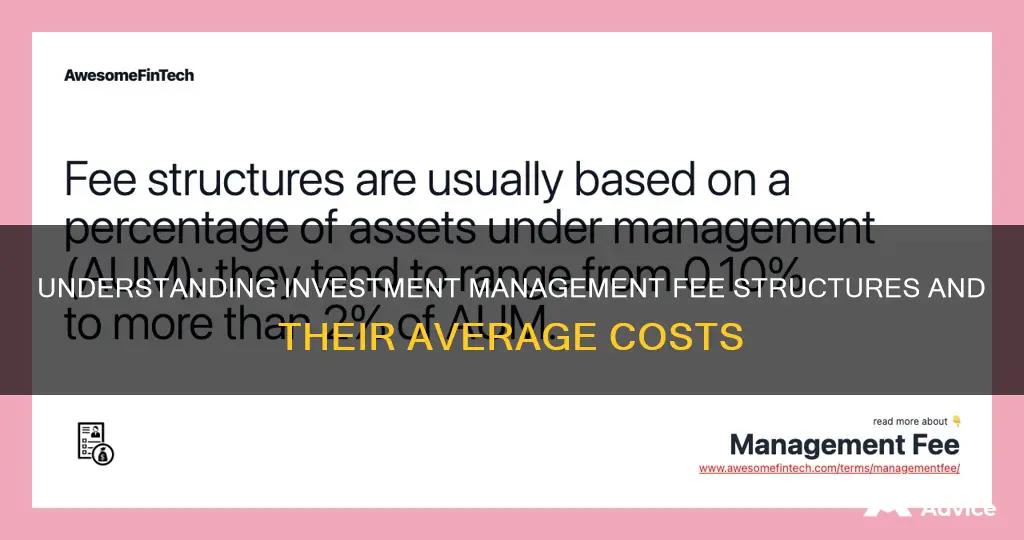
Investment management fees can vary significantly depending on the type of investment, the investment method, and the investment manager. The average investment management fee typically ranges from 1-2% of the assets under management (AUM). However, in recent years, due to technological advancements and increased awareness, these fees have decreased to around 1%. It's important to note that the fee structure can also differ, with some advisors charging flat fees, hourly rates, or a combination of different fee types. When considering investment management, it is crucial to understand the different fee structures and choose the option that aligns with your financial goals and preferences.
| Characteristics | Values |
|---|---|
| Management Fee Range | 0.10% to more than 2% of AUM |
| Average Management Fee | 1-2% of AUM |
| Average Management Fee in Recent Years | 1% of AUM |
| Flat Annual Fee (Retainer) | $2,000 to $7,500 |
| Hourly Rate | $200 to $400 |
| One-time Financial Plan Fee | $1,000 to $3,000 |
| Commission | 3% to 6% of an investment |
What You'll Learn

Management fees for investment funds
Management fee structures are typically based on a percentage of assets under management (AUM). The fees can range from as low as 0.10% to more than 2% of AUM. This variation in fees is generally due to the investment method used by the fund manager. Actively managed funds, which involve more frequent trading and portfolio adjustments, tend to have higher management fees compared to passively managed funds.
According to industry averages, investment management fees for advisory services typically range between 1-2% of assets under management. However, in recent years, due to technological advancements and increased awareness, these fees have been closer to an average of 1%. It is important to note that these fees are often negotiable and can be reduced as the amount of AUM reaches certain breakpoints.
In addition to management fees, there are other types of fees associated with investment funds, such as sales fees (including load fees and ongoing sales fees), trading costs, expense ratios, and insurance product costs. These fees can vary significantly and it is important for investors to be aware of them to make wise financial decisions and avoid unnecessary expenses.
Investment Management Fees: Industry Standards and Expectations
You may want to see also

External and internal fees
Investment management fees can be categorised into two main types: external fees and internal fees. External fees occur outside the financial product, while internal fees occur inside the financial product as an operating expense. Here's a more detailed breakdown of these two types of fees:
External Fees
Advisor (Management) Fees
If you hire a financial advisor or investment professional, they will typically charge a fee for managing your investments. This is known as an investment management fee and usually ranges between 1-2% of your total assets, with some sources stating that this has fallen closer to an average of 1% in recent years. This fee may be negotiable and is often based on a percentage of your assets under management (AUM). For example, a mutual fund's management fee might be stated as 0.5% of AUM.
Sales Fees (Commission-Based)
These fees are associated with agents or brokers who sell financial products, as they receive a commission. Examples of sales fees include load fees, which can be front-loaded (paid upfront when the investment is purchased) or back-loaded (paid when the investment is sold), and ongoing sales fees, which are paid annually for the duration of the investment. Sales fees typically range from 1-8% of the investment amount.
Trading Cost (External)
This is a custodial fee incurred when you buy or sell a security. The cost varies depending on the company holding your investments. Low-cost custodians like TD Ameritrade, Schwab, Fidelity, and E*Trade usually charge less than $10 per trade.
Expense Ratio
This is an annual fee deducted from the investor's balance and typically ranges between 0.05% and 2%. Passively managed funds tend to have lower expense ratios than actively managed funds. International and emerging market funds generally have higher expense ratios than domestic funds.
Internal Fees
Trading Costs (Internal)
Investment managers incur these costs when they buy and sell individual positions within a fund. These costs can increase due to factors such as the bid-ask spread of a stock and the number of trades inside the fund.
Insurance Product Costs
These costs are associated with insurance-based investment products, such as annuities or investments within life insurance policies. There are several types of charges within insurance products, including insurance-related fees, surrender charges if you want to exit the investment early, rider charges for additional benefits, and investment management fees charged by the insurance company. These fees can add up quickly, making insurance-based investments less attractive from a cost perspective.
Strategic Portfolio Weighting: Key Factors for Investment Success
You may want to see also

Advisor fees
It's important to note that investment advisor fees are typically negotiable and often depend on the overall AUM. As the amount of investment AUM increases, the fee is usually reduced, similar to marginal tax brackets. If you're paying more than 1%, you should be receiving personalised financial planning services.
Additionally, it's worth mentioning that some financial advisors charge a flat fee, which may be more financially sensible for those with over $1 million in assets. For instance, a flat fee of $10,000 on a $3 million portfolio would result in significant savings compared to a standard fee of 0.8%-1%.
To ensure transparency, you can look up your advisor's Form ADV Part 2, which provides full disclosure of their fee structure under "Item 5: Fees and Compensation". This form is available on the SEC website.
Savings Investment: Choosing Wisely for Your Future
You may want to see also

Sales fees
Some mutual funds impose a sales charge when you purchase shares. These loads are essentially commissions that pay the professional adviser or broker who sold you the fund. There are also thousands of no-load funds that market directly to the public and have no salespeople. If you choose to research and invest in funds on your own, there is no need to pay this commission.
Sales charges can vary greatly, but 5.75% is a typical figure. For example, if you invest $1,000 in a fund charging a 5.75% load, $57.50 will be subtracted upfront and $942.50 will be invested in the fund's shares. A 5.75% sales charge thus works out at about 6.1% of your net investment.
It is important to remember that fees are one of the most important determinants of investment performance and are something every investor should focus on. Minimising fees tends to maximise performance over time, but it is also important not to let fees dominate your investment decision-making process.
Transferring Your Investment HSA to Savings: A Step-by-Step Guide
You may want to see also

Trading costs
External Trading Costs
External trading costs are custodial fees charged by the company holding your investments for completing a buy or sell order of a security trade. Low-cost custodians like TD Ameritrade, Schwab, Fidelity, and E*Trade usually charge fees of less than $10 per trade. Each custodian has a list of securities that are not subject to trading fees. These can be found by searching for no-cost ETFs, index funds, or mutual funds with your current custodian. This is especially beneficial for investment accounts with low balances.
Internal Trading Costs
Internal trading costs are incurred by investment managers when they buy or sell individual positions within a fund. This cost can increase depending on the bid-ask spread of the stock and the number of trades inside the fund. These costs are unavoidable, so there is no need to worry about trying to minimise them. The bid-ask spread refers to the difference between the highest price a buyer is willing to pay for a security (the bid) and the lowest price a seller is willing to accept (the ask). A large bid-ask spread indicates higher trading costs.
Public Saving and Investment: Two Sides of the Same Coin?
You may want to see also
Frequently asked questions
An investment management fee is a charge levied by an investment manager for overseeing an investment fund. This fee is intended to compensate managers for their time and expertise in selecting stocks and managing the portfolio.
The average investment management fee is between 1-2% of assets, with some sources stating that in recent years this has fallen closer to 1%.
Investment management fees can vary depending on what is being bought or sold and by whom. For example, fees charged by a registered investment advisor may differ from those charged by a broker or agent. The fee may also depend on the investment method used by the fund manager, with more actively managed funds incurring higher fees than passively managed funds.
You can ask your financial advisor to be transparent about their fees. If they are not, you may be able to look up their Form ADV Part 2, which provides full disclosure of their fee structure.







